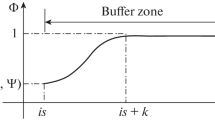Abstract
Laminar-to-turbulent transition in hypersonic boundary layer is numerically investigated using the direct-numerical simulation (DNS) method combined with the linear stability theory (LST). The DNS-LST framework is validated first for 2D hypersonic boundary layer. The growth of the Mack second mode is matched well to previous DNS data. A complete 3D turbulent transition at Mach 6 is computed in the current DNS to demonstrate the capability of the current method for a whole 3D turbulent transition scenario. Two modes are assigned at the DNS inlet for the fundamental breakdown in the hypersonic boundary layer: the Mack second mode (the fundamental mode) and the pair of oblique waves of the fundamental frequency. These instability modes are obtained from the stability analysis. The current DNS successfully resolves the 3D turbulent transition in the hypersonic boundary layer. Computational data are investigated to identify major flow features associated with the fundamental breakdown phenomena. Major instability modes are analyzed in the late transient stage.











Similar content being viewed by others
Data availability
The data that support the findings of this study are available from the corresponding author upon reasonable request.
References
Mack LM (1984) Boundary-layer linear stability theory. Tech. rep., California Inst of Tech Pasadena Jet Propulsion Lab
Malik MR (1989) Prediction and control of transition in supersonic and hypersonic boundary layers. AIAA J 27(11):1487–1493
Fedorov A (2011) Transition and stability of high-speed boundary layers. Annu Rev Fluid Mech 43:79–95
Horvath T, Berry S, Merski N, Berger K, Buck G, Leichty D, Schneider S (2006) In: 9th AIAA/ASME Joint Thermophysics and Heat Transfer Conference. https://doi.org/10.2514/6.2006-2919
Horvath T, Tomek D, Splinter S, Zalameda J, Krasa P, Schwartz R, Gibson D, Tietjen A, Berger K (2010) In: 48th AIAA Aerospace Sciences Meeting Including the New Horizons Forum and Aerospace Exposition. https://doi.org/10.2514/6.2010-241
Reed HL, Saric WS, Arnal D (1996) Linear stability theory applied to boundary layers. Annu Rev Fluid Mech 28(1):389–428
Franko KJ, Lele SK (2013) Breakdown mechanisms and heat transfer overshoot in hypersonic zero pressure gradient boundary layers. J Fluid Mech 730:491–532
Di Renzo M, Urzay J (2021) Direct numerical simulation of a hypersonic transitional boundary layer at suborbital enthalpies. J Fluid Mech 912:A29
Leinemann M, Hader C, Fasel HF (2021) In: AIAA Scitech 2021 Forum, p 1739
Li X, Fu D, Ma Y (2010) Direct numerical simulation of hypersonic boundary layer transition over a blunt cone with a small angle of attack. Phys Fluids 22(2):025105
Sivasubramanian J, Fasel HF (2015) Direct numerical simulation of transition in a sharp cone boundary layer at Mach 6: fundamental breakdown. J Fluid Mech 768:175–218
Hader C, Fasel HF (2018) Towards simulating natural transition in hypersonic boundary layers via random inflow disturbances. J Fluid Mech 847:R3
Lim J, Kim M, Kim S, Jee S, Park D (2021) Cost-effective and high-fidelity method for turbulent transition in compressible boundary layer. Aerosp Sci Technol 108:106367
Jee S, Joo J, Lin RS (2018) Toward cost-effective boundary layer transition computations with large-Eddy simulation. J Fluids Eng. https://doi.org/10.1115/1.4039865111201
Kim M, Lim J, Kim S, Jee S, Park J, Park D (2019) Large-eddy simulation with parabolized stability equations for turbulent transition using OpenFOAM. Comput Fluids 189:108–117
Kim M, Lim J, Kim S, Jee S, Park D (2020) Assessment of the wall-adapting local eddy-viscosity model in transitional boundary layer. Comput Methods Appl Mech Eng 371:113287. https://doi.org/10.1016/j.cma.2020.113287
Kim M, Kim S, Lim J, Lin RS, Jee S, Park D (2021) Effects of phase difference between instability modes on boundary-layer transition. J Fluid Mech 927:A14. https://doi.org/10.1017/jfm.2021.732
Duan L, Choudhari MM, Zhang C (2016) Pressure fluctuations induced by a hypersonic turbulent boundary layer. J Fluid Mech 804:578–607
Huang J, Duan L, Casper KM, Wagnild R, Bitter N (2020) In: AIAA Scitech 2020 Forum, p 1065
Spall R, Malik M (1989) Goertler vortices in supersonic and hypersonic boundary layers. Phys Fluids A 1(11):1822–1835
Di Renzo M, Fu L, Urzay J (2020) Htr solver: an open-source exascale-oriented task-based multi-gpu high-order code for hypersonic aerothermodynamics. Comput Phys Commun 255:107262
Fu L, Hu XY, Adams NA (2016) A family of high-order targeted ENO schemes for compressible-fluid simulations. J Comput Phys 305:333–359
Lim J, Kim M, Park J, Kim T, Jee S, Park D (2022) Simulation of hypersonic boundary layer on porous surfaces using OpenFOAM. Comput Fluids 240:105437
Zhao R, Wen C, Long T, Tian X, Zhou L, Wu Y (2019) Spatial direct numerical simulation of the hypersonic boundary-layer stabilization using porous coatings. AIAA J 57(11):5061–5065
White FM (2006) Viscous fluid flow, 3rd edn. McGraw-Hill
Van Driest ER (1956) The problem of aerodynamic heating. Aeronaut Eng Rev 15(10):26–41
Chang CL, Malik MR (1994) Oblique-mode breakdown and secondary instability in supersonic boundary layers. J Fluid Mech 273:323–360
Acknowledgements
This work was supported by the National Research Foundation of Korea (NRF) grant funded by the Korea government MSIT (Ministry of Science and ICT) for the project Turbulent Transition Control in Hypersonic Boundary Layer Flow (No. NRF-2021R1A2C1006193).
Author information
Authors and Affiliations
Corresponding author
Ethics declarations
Conflict of Interest
On behalf of all authors, the corresponding author states that there is no conflict of interest.
Additional information
Publisher's Note
Springer Nature remains neutral with regard to jurisdictional claims in published maps and institutional affiliations.
Rights and permissions
Springer Nature or its licensor (e.g. a society or other partner) holds exclusive rights to this article under a publishing agreement with the author(s) or other rightsholder(s); author self-archiving of the accepted manuscript version of this article is solely governed by the terms of such publishing agreement and applicable law.
About this article
Cite this article
Bae, H., Lim, J., Kim, M. et al. Direct-Numerical Simulation with the Stability Theory for Turbulent Transition in Hypersonic Boundary Layer. Int. J. Aeronaut. Space Sci. 24, 1004–1014 (2023). https://doi.org/10.1007/s42405-023-00626-z
Received:
Revised:
Accepted:
Published:
Issue Date:
DOI: https://doi.org/10.1007/s42405-023-00626-z




